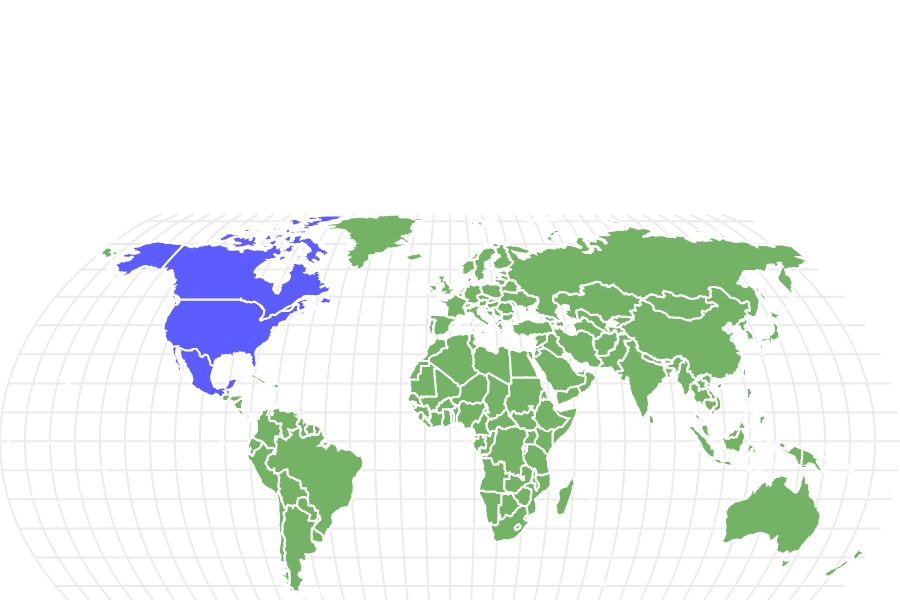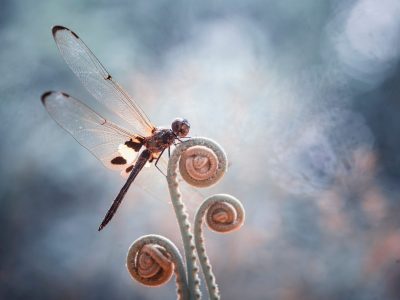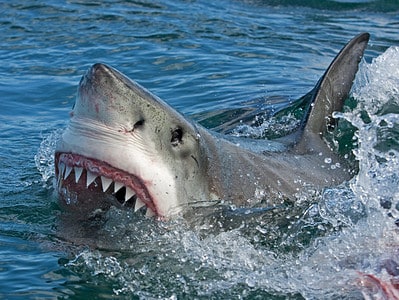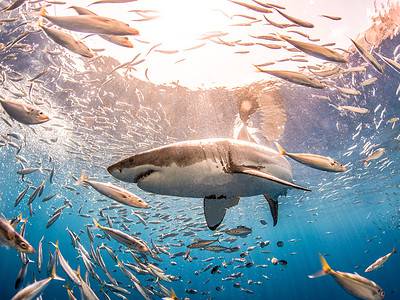Dark-Eyed Junco
Junco Hyemalis
Advertisement
Dark-Eyed Junco Scientific Classification
- Kingdom
- Animalia
- Phylum
- Chordata
- Class
- Aves
- Order
- Passeriformes
- Family
- Passerellidae
- Genus
- Junco
- Scientific Name
- Junco Hyemalis
Read our Complete Guide to Classification of Animals.
Dark-Eyed Junco Conservation Status
Dark-Eyed Junco Facts
- Prey
- Caterpillars, Beetles, and Ants
- Name Of Young
- Hatchlings
- Group Behavior
- Solitary/Pairs
- Estimated Population Size
- 630 million
- Biggest Threat
- Climate Change
- Wingspan
- 7.1 to 9.8 inches
- Incubation Period
- 12-13 days
- Age Of Fledgling
- 10-13 days
- Habitat
- Forests
- Predators
- Hawks, Shrikes, Owls
- Diet
- Omnivore
- Number Of Species
- 15
- Nesting Location
- Varies
View all of the Dark-Eyed Junco images!
Summary
This forest bird, the Dark-Eyed Junco, is one of the most abundant in North America.
The Dark-Eyed Junco is a small sparrow that is the most abundant forest bird in North America. While its body coloring can vary depending on the sub-species and region, they have distinctive bright white tail feathers that can be seen during flight.
They can be found foraging on the ground for seeds and insects throughout the United States in winter.
3 Amazing Dark-Eyed Junco Facts
- Dark-Eyed Juncos are the most common bird in North America. They can be found in the winter across the entire continent, from Northern Mexico to Alaska and coast to coast.
- They have been described as “snowbirds.” In the eastern United States, they will appear in the wintertime, only to disappear in the spring each year. They retreat to the North and higher elevations to breed in the summertime.
- Dark-Eyed Juncos have different color variations that make up 15 different sub-species. The sub-species tend to stay in different geographic regions to breed but can be seen flocking together in the wintertime.
Where to Find Dark-Eyed Juncos
During the summer, Dark-Eyed Juncos breed in Northern Canada and the higher elevations of the United Stations. The best time to find them is in the winter months throughout the United States and Northern Mexico.
They forage the ground for food, so look for them around open, partially wooded areas. They can also be found foraging under bird feeders and typically travel in flocks. These flocks can be interesting to bird watchers since multiple species will often flock together.
Dark-Eyed Junco Nests
Females will build nests typically near the ground around sloping rocky areas in the tangled roots of a fallen tree. They will also build around humans in or underneath buildings. Occasionally, they will build just above the ground in branches or building overhangs.
The nest can vary depending on this range of locations. The nest can be just a lining of vegetation on the ground, and off the ground, it can resemble a typical nest of twigs, moss, and leaves.
The inside of the nest is lined with finer material such as grass and hair. The nest takes 3-7 days to build. The female uses her body to determine the size of the nest, so they will typically be around 3-6 inches across, with an inner diameter of about 2.5 inches.
Dark-Eyed Junco Scientific Name
The Dark-Eyed Junco is a species of Junco, a group of New World Sparrows. It has the Scientific name Junco hyemalis. Junco is the Spanish word for “rush” from the Latin juncus. The scientific name means “winter junco.” The Latin word hyemalis means “of the winter.”
There are fifteen subspecies recognized. All of the subspecies and very similar in shape and size, with the only variation being the coloring.
- Slate-colored group – These subspecies have slate-gray heads, breasts, and upper body.
- J. h. hyemalis: Slate-colored dark-eyed junco
- J. h. carolinensis: Carolina dark-eyed junco
- J. h. cismontanus: Cassiar dark-eyed junco
- White-winged group – This subspecies has a medium-gray head, breast, and upper body. It has a whiter tail than the other subspecies.
- J. h. aikeni: White-winged dark-eyed junco
- Oregon or brown-backed group – These subspecies have a blackish-gray head and breast with a brown back and wings.
- J. h. montanus: Montana dark-eyed junco
- J. h. mutabilis: Nevada dark-eyed junco
- J. h. oreganus: Oregon dark-eyed junco
- J. h. pinosus: Point Pinos dark-eyed junco
- J. h. pontilis: Laguna Hanson dark-eyed junco
- J. h. shufeldti: Shufeldt’s dark-eyed junco
- J. h. thurberi: Thurber’s dark-eyed junco
- J. h. townsendi: Townsend’s dark-eyed junco
- Pink-sided group – This subspecies has a lighter gray head and breast than the Oregon subspecies. Its back and wings are brown. It has a pinkish color that covers more of the flanks and breast than the Oregon subspecies.
- J. h. mearnsi: pink-sided dark-eyed junco
- Gray-headed group – This subspecies is mostly light gray with a rusty-brown back.
- J. h. caniceps: gray-headed dark-eyed junco
- Red-backed group – This subspecies is similar to the gray-headed subspecies but has a more silver-colored bill with a dark-colored upper and light-colored lower mandible.
- J. h. dorsalis: red-backed dark-eyed junco
Dark-Eyed Junco Size, Appearance, & Behavior
The Dark-Eyed Junco is a medium-sized sparrow that, depending on subspecies, can vary in color. They generally have gray heads, necks, and breasts. Their wings and backs are usually gray or brown, their belly is white, and their outer tail feathers are noticeably white in flight. They also have dark coloring around their eyes, hence the name.
The Dark-Eyed Junco length is generally 5.1 to 6.9 inches, the wingspan is 7.1 to 9.8 inches, and they can weigh between .6 and 1 ounce.
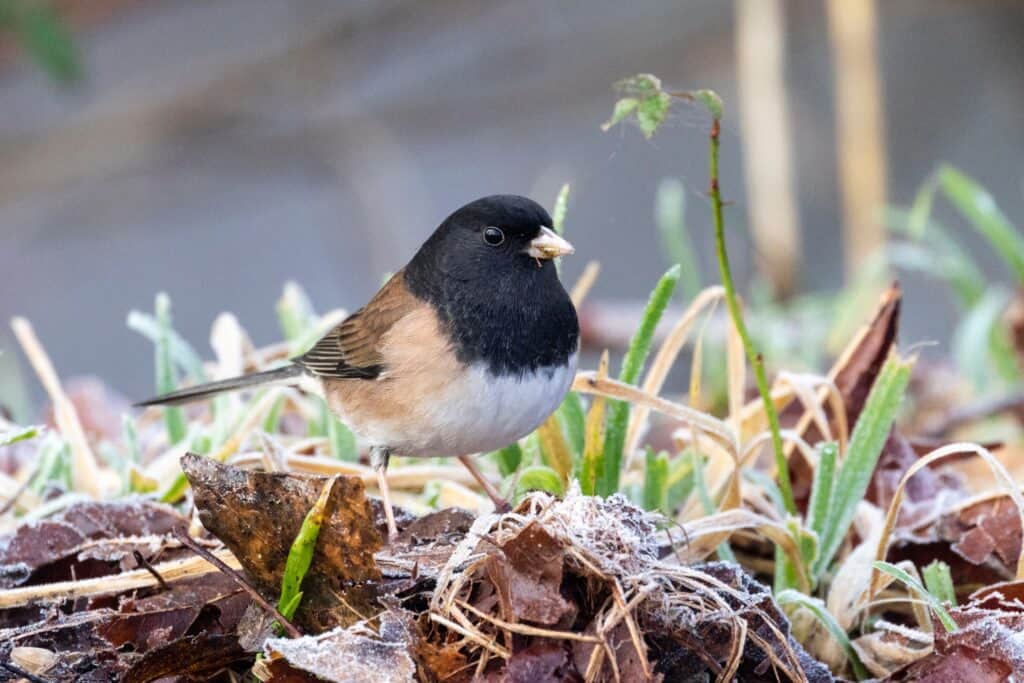
Dark-eyed juncos measure up to 6.3 inches in length and weigh up to 1.1 ounces.
©Feng Yu/Shutterstock.com
Dark-Eyed Junco Migration Pattern and Timing
In the spring, the Dark-Eyed Junco will fly to Northern Canada to breed, and none are found in the United States.
They return to the United States and northern Mexico in the late fall and early winter. This characteristic is what their scientific name is based on, “winter junco.”
Dark-Eyed Junco Diet
The Dark-Eyed Junco mainly forages on the ground for seeds. Their main diet is the seeds from sorrel, lamb’s quarters, chickweed, buckwheat, and other similar grasses.
They will also feed at bird feeders and prefer millet over sunflower seeds. During breeding, they will also eat insects such as ants, flies, caterpillars, butterflies, beetles, and moths.
What Does the Dark-Eyed Junco Eat?
Seeds of grasses and insects.
Dark-Eyed Junco Predators, Threats, and Conservation Status
The Dark-Eyed Junco is one of the most common birds in North America. Since it breeds in the northern remote areas of Canada, impacts from humans are minimal. Because of this, conservation concerns are very low.
What Eats Dark-Eyed Juncos?
Typical predators include cats, bats, foxes, snakes, eagles, hawks, and owls. Since these small birds typically forage on the ground for food, they can be ambush targets. For example, a cat may lay and wait to ambush one in a grassy field.
Dark-Eyed Juncos are very territorial in the summer and will chase off intruders near their nests by diving at them rapidly while chirping excitedly.
Reproduction, Young, and Molting
The female Dark-Eyed Junco will typically lay between 3-6 eggs in the late spring and early summer. The eggs will hatch 12-13 days later, and the young will leave the nest around 10-13 days after hatching.
Population
It is estimated that there are 630 million Dark-Eyed Juncos in North America. Surveys suggest that the population trend has been declining about 0.7% per year since 1966.
Partners in Flight rates the species 8 out of 20 on the Continental Concern Score, indicating a low conservation concern.
View all 110 animals that start with DDark-Eyed Junco FAQs (Frequently Asked Questions)
Do Dark-Eyed Juncos Migrate?
Yes, they migrate to Northern Canada to breed in the summertime.
How many eggs do Dark-Eyed Junco lay?
Typically, these birds lay between 3-6 eggs.
How fast does Dark-Eyed Junco fly?
They are very agile and can dart quickly across the ground and through undergrowth and vegetation.
However, we do not have an exact speed for these birds.
What is Dark-eye Junco’s wingspan?
Their wingspan is 7.1 to 9.8 inches.
When do Dark-Eyed Junco leave the nest?
These birds mature pretty fast, leaving the nest after only 10-13 days.
Thank you for reading! Have some feedback for us? Contact the AZ Animals editorial team.
Sources
- Wikipedia / Accessed October 3, 2022
- All About Birds / Accessed October 3, 2022
- Audobon / Accessed October 3, 2022
- (1970)

